
By Carl Valle
It is no secret that Al Vermeil is one of the biggest names in professional sports. His success with the Chicago Bulls and San Francisco 49ers is well documented with strength and conditioning coaches and performance specialists. Coach Vermeil is well known to be a life learner, and although Michael Jordan and Joe Montana can make anyone look good, independently his methods still stand the test of time. The 40 yard dash while limited to extrapolating to performance directly, has some merit in showing how an athlete can accelerate to near top speed by breaking it down into several segments from 0-10,10-20, 20-30, and 30-40 yards. In several presentations by one of the most influential coaches in strength and conditioning history, Coach Vermeil clearly outlined how each segment in the 40 can be improved with various training protocols. At first glance nearly 50 slides were very overwhelming to many who are not experienced strength coaches, but a simpler approach to speed and power sports can be applied. Even if one doesn’t apply all of the methodologies and training options, it’s a good way to see if your training is improving by timing each segment to if individual exercise selections are influencing improvements in the acceleration curve. It’s possible to not need any specific option, but using his suggestions are great ways to prepare athletes for speed development as they help address acceleration in many different ways, and having more options is better than having constraints. Many team sports find training time and energy to be limited, so options outside of running may complement the practices and reduced sprinting exposure.
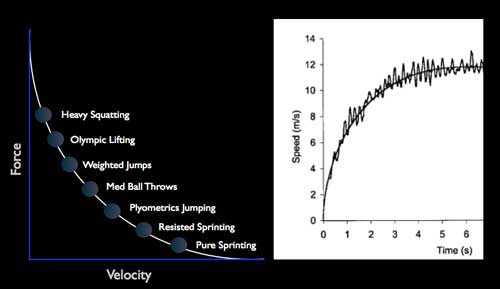
Chart 1: the modalities that are commonly used to help athletes improve performance over an acceleration curve.
The classic graphic of the force / velocity curve is a little misleading as it may direct the reader to believe that sprinting is just moving fast without any force to the ground, but it does illustrate the contraction rates and the limitations of applying force with little time. What is helpful is the curve does mirror the acceleration pattern, show how eventually one is going to hit maximum speed, a period of time that is also terminal acceleration when the athlete can no longer accelerate. In the training modalities below, an estimated and crude zone of transfer is shown with red highlights, with the darker tone emphasizing a higher influence of carryover. While far from perfect, the zones are very similar to what Al Vermeil has described and what the science validates with trained athletes. Some disagreement within the sport science literature does exist, but this rough outline is strong enough to be supported with research. Keep in mind that most training programs are only doing one modality, so no specific option will be dominant unless a heavy emphasis is done. Short sprinting programs with nearly any safe modality will improve everywhere in the 40, so it’s a safe bet that trying to do all of them isn’t necessary and may be counterproductive if not done properly.
Heavy Squatting (Maximum Strength)
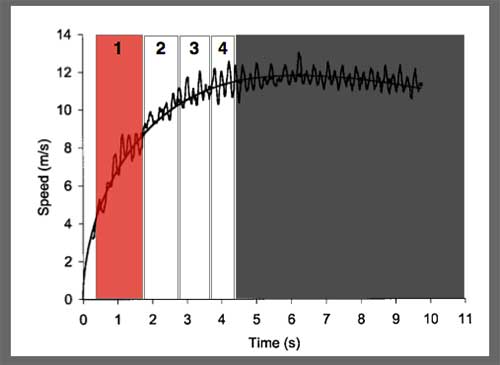
Chart 2: Heavy Squats
Heavy external loading, be it squatting or other exercises that promote lower body maximal strength has a strong correlation to the first few steps, the slowest by the way, in acceleration. The most obvious reason why heavy maximal loading helps is that the value of the first few steps is so precious because they are slow, or have larger contact times. A long contact time is far more trainable from an array of options, but maximum strength, can improve a lot of novice or intermediate athletes provided it’s safe and sane. Unfortunately past 5 meters or the first 4 or more steps the influence of maximal strength dwindles, and, many athletes have developed the ability to accelerate rapidly without impressive numbers in the weight room. As the weight of the athlete increases, the power to weight ratio will decrease, as we see plenty of 200 pound athletes jump 40 inches, but very few 300 pound athletes are known to have such abilities. Also acceleration begins with two legs from time to time so bilateral options are favorable in improving the quality of starting speed. Advanced athletes tend not to improve in maximal strength as they hit a genetic ceiling, and many great lifters are simply not fast as too much resources can be spent in the weight room when on the field running is important. Many coaches find that back and front squats should be at a level that it is near 1.8-2.0 times bodyweight for advanced athletes, and loads past that seem not to have much transfer.
Zone of Improvement: The first zone is mainly affected by maximal strength qualities such as heavy squatting at intermediate and advanced development. Paired with sprinting at longer distances, the combination may be sufficient to cover all zones, but in isolation it’s primary influence is the first initial zone.
Olympic Lifting
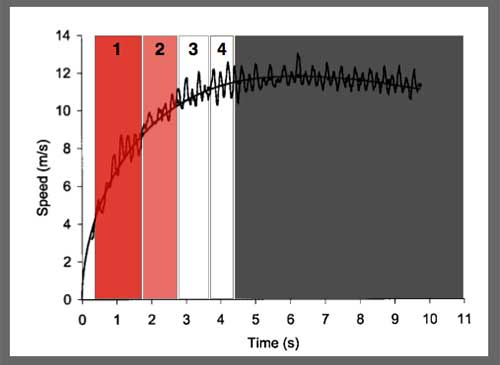
Chart 3: Olympic Lifting
Using cleans, snatches, and jerks to develop power is popular because the movements have a combination of bar speed (velocity) and load beyond one’s body weight. Loads heavier than one’s body weight tend to help overcome inertia and the ability to create forces rapidly. Olympic lifting has a lot of general qualities that can help athletes on the field be explosive, and based on the literature have unique adaptations to the body as a whole that maximum strength does not. One doesn’t need to do any specific exercise to improve, but since the options are validated in helping athletes improve in early acceleration, they may be good choices for larger athletes needing to reduce the lower leg strain that jump training seems to have. Olympic lifting, commonly called weightlifting to those who employ or participate in the sport, does require good instruction like any part of training and should be seen as a long term investment rather than a quick to implement method. The lightest options will be snatches and cleans need the ability to front squat in general more than used. Expressing power in weight training is compared by bodyweight, so loads of about 1.2-1.5 seem to elicit responses that improve more advanced athletes.
Zone of Improvement: Like heavy squatting, the first zone is highly affected with some contribution to transfer in the second zone, due to the higher range of options the weight lifts have in training.
Weighted Jumps
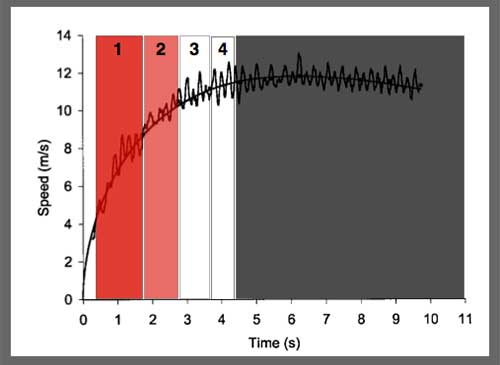
Chart 4: Weighted Jumps
Located between the Olympic lifting and medicine ball options on the force velocity curve, weighted jumps are popular because they are simple to do and allow for heavier external loads than most medicine ball options. Some athletes can’t perform Olympic lifts for various reasons, and the repeated jumping options create elastic responses that some coaches and athletes respond favorably to. Weighted jumps are an excellent option for developing power and elasticity beyond the first few steps. Weighted jumps can be done with barbells, dumbbells, weighted vests, or other resistance options making them popular because they are flexible. Coaches find jumping in place with the loads a safe option, but some horizontal jumping with lighter loads is possible if the displacement isn’t overly excessive and the external loads are not risking injury to the Achilles and foot. Weighted jumps are sometimes tough for knees that are prone to what is commonly known to jumper’s knee, so sometimes Olympic lifting or other options may get similar results without the overload.
Zone of Improvement: Most applied options to jump training use a moderate to heavy load with low rep schemes, making them strong options for the first zone and some benefit for the second zone. If the loads are light, the transfer or carryover may be higher in the second zone.
Medicine Ball Training
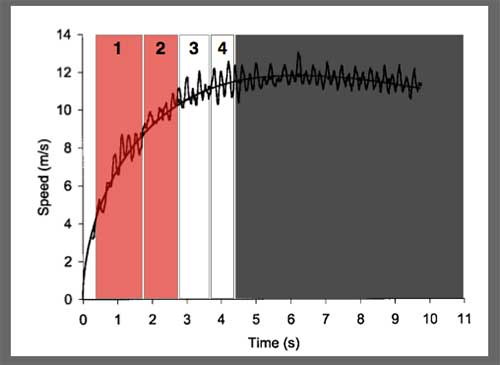
Chart 5: Medicine Ball Throws
Many coaches and athletes think of medicine balls as upper body or torso training options, but throwing medicine balls is a great option, similar to plyometrics but with a projection. The use of throwing medicine balls is a simple way to get the body to a natural summation of forces from the legs all the way up through the upper body. The coordination of being a total body throw without the complexity of Olympic weight lifts makes medicine balls great teaching tools long term but a flexible option short term. The primary option coaches like is the explosive overhead throws one can do from a static start, but repeated elastic throws with or without a pre-jump is especially helpful for athletes wanting to get deep leg explosions. Placed between in place jumps and Olympic style weightlifting, medicine ball training is also great to teach how to create forces through the legs with an external implement, something that helps prepare for the use of cleans, snatches, and jerks later. Medicine ball training can vary more than just loads of the medicine ball (1 kg to 10kg), but most use bilateral jump like movements with pushing or scooping like movements to get total body explosions for distance or heights, distance, all getting various depths in leg angles, and muscle recruitments. Medicine ball training while unique, does overlap the plyometrics and weighted jumping training slightly.
Zone of Improvement: Medicine ball throws are great teaching tools, but from a training influence are not as strong as heavier load options or specific and high velocity options such as plyometrics and sprints. Medicine ball throws are excellent testing tools but are mainly used in single explosions repeated versus repeated continuous jumping, so they have limits in application. It is important to look at skill teaching and training adaptions to the body, as all training and teaching need to be covered.
Plyometrics (Explosive Jump Training)
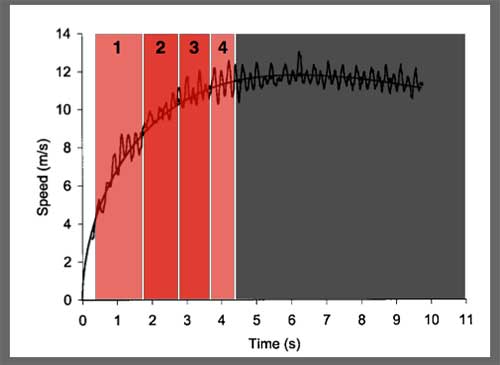
Chart 6: Plyometrics
Jump training, be it hopping on one leg repeatedly, jumping on two legs, or alternating between legs is helpful for many athletes who lack elastic power. Elasticity is the ability to utilize stored energy in the muscles and tendons to transfer energy of gravity and the body from the ground. Change of direction abilities are more affected by plyometric training since the ability to reaccelerate the body is unique to the movements outside the weight room because of the huge eccentric forces. Regardless if it’s straight ahead sprinting or change of direction work, plyometrics are good options if the exercises and work is managed properly. Good loading volumes leave the athlete feeling they have room for more, and good execution feels and looks good. It’s beyond a paragraph to explain proper technique and implementation of plyometrics, but it’s a no-brainer doing any new exercises without instruction is a path to failure and injury. As the athlete increases size, say linebackers to linemen, it’s advisable to start looking at the percentage of single leg and double leg usage to avoid overload to joints, since as the bodyweight increase the power to weight ratio decreases. Explosive jump training can include external loads, such as weighed jump squats with barbells, dumbbells, and weighted vests. Some coaches are proponents of blending the amount of horizontal jumps with vertical jumping actions to focus on different qualities, but specificity is never as effective as total body sprinting normally.
Zone of Improvement: All zones are influenced by plyometrics and it’s debatable if the combination of sprinting will wash out some of the effects as it’s near to the velocity rates, other adaptations may be of use.
Resisted Sprints
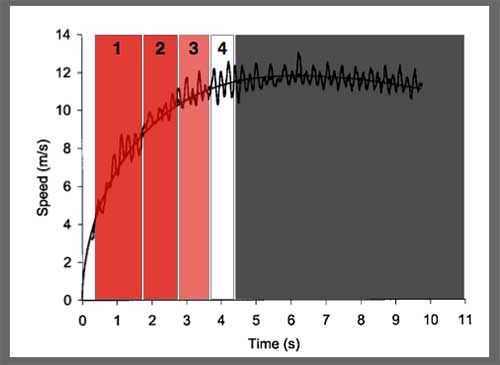
Chart 7: Resisted Sprinting
The use of sleds or sometimes low grade hills is a very natural way to overload the body specifically since the combination of sprinting and external load at similar speeds is a timeless way to help acceleration. A big difference between sled sprinting (low resistance and high speed) and sled pushing ( high resistance and low speeds) as very little information on the effectiveness of the latter being effective in speed development versus lighter options. A speed sled creates a horizontal load tied to the athlete’s hip or chest, and weight plates are used to create the correct resistance for the athlete. The most obvious question is what load is the most effective and that is very debatable with research usually showing different results. A good idea is to look at the mechanics and time the early parts of the runs say first 25 meters or yards. Acceleration development responds very well to sleds based on the literature, and using a load near 10-20% bodyweight with efforts that are near maximal is advantageous. Now that electronic timing has proliferated, getting speed or splits to see what loads are helping different parts of the run is an option. Coaches can adjust the loads to see if athletes have great 20 yard times, meaning the load is not too heavy that the second 10 is not too slow or adjust the weight higher if athletes are getting stronger in the weight room as well as faster on the track. A simple example of how important testing speed is two athletes being the same weight, say 185 pounds. Both can be the same body composition, meaning the same amount of fat and muscle, but one can be dramatically stronger than the other, especially if he is a few years older with more training experience. Using just a percentage of weight would be a problem if one wanted to see if the load was appropriate unless they timed.
Zone of Improvement: The first three zones are highly influenced, but the last zone is minimal if at all due to the speeds and upright posture one is at because of the starting position. If the sled load is much higher, the first zone may be influenced more but then the lower velocities will not allow for faster speeds that could improve the later zones.
Pure Sprinting
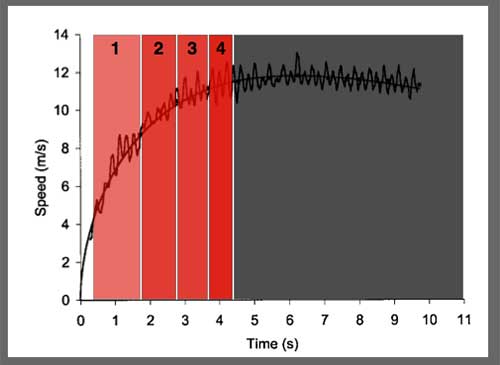
Chart 8: Pure Sprinting
The most direct way to run faster is to simply sprint at different distances and at different speeds. General sprinting is one of the most effective ways to become more athletic and one of the best ways to improve combine performance, provided that one is fully rested. Unfortunately we have a “blinded by the obvious” phenomenon with using simple and straightforward methods to getting faster are not primary options. One only needs a field or track and the right attire to sprint, but for some reason many coaches and athletes are seduced by adding gadgets or external equipment. Sprinting raw, with no equipment or device, should be the bulk of one’s training in order to rehearse an imprint faster rates of contractions to the nervous system. Many coach find that sprinting sometimes has a risk of injury because athletes are not use to sprinting without a ball or sport equipment from overspecialization, and avoid the training. The same coaches are also confused why athletes are pulling muscles, especially the hamstring group and adductors in games. The simple fact is the body must be prepared to handle outputs in games by simulating to a point the conditions that will be exposed to athlete eventually. To avoid injury, it’s best to use a day or two of rest and warm-up thoroughly and communicate how the body is feeling before sprinting. One doesn’t need to sprint all out to get faster, one just needs to train faster than before to improve. A classic adage of 90% effort to get near 100% speed is a smart way to hold back an athlete just enough to dodge injury but get enough speed in to improve. Obviously the use of timing can help a coach get both the distance and the speed (work or output) to manage fatigue during the training week.
Zone of Improvement: All zones are influenced, but the last segment is the most limited in improvement and highly dependent to the specificity of running. Since pure sprinting has no change in external load, the first zone is less affected but still can be developed over time, but with slower progress at intermediate levels. Just learning with neophytes or having an experienced sprinter will lead to improvements from specificity, but rapid developments can come from resistance training in the first zone.
A little trial and error will be necessary to see what options best fit in a program. The most successful programs usually incorporate some combination of above to improve an athlete and a balanced approach yields the most consistent results and the lowest injury rates because risk is mitigated and distributed. Coaches and athletes should look to their own situations and decide what is best for them, only by looking at the record keeping of the training and the splits of each zone to see what is working.
Please share this article so others may benefit.
[mashshare]

Nice graphs and visuals – do you have some recommended citations/sources for this info?